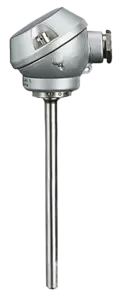

Screw-in RTD temperature probe
- Temp.: -50 to +600 °C
- Terminal heads BUZ/BUZH/BBK
- Temperature sensor Pt100/Pt500/Pt1000



























































RTD stands for "Resistant Temperature Detector" and refers to a temperature probe that utilizes the interaction of ohmic resistance and temperature. For this reason, the probe is also referred to as a resistance thermometer. Depending on the application, RTDs are available with different resistance elements.
Platinum-chip temperature sensors are generally used in RTDs. From the user's point of view, platinum offers the great advantage of having long-term stability. Mostly a Pt100 sensor is used. The designation "Pt" stands for platinum and the number "100" for 100 Ω basic resistance at 0 °C. The resistance of the Pt100 increases by about 0.38 Ω per kelvin temperature increase. Pt1000 temperature sensors are also found in industrial applications. Here, the electrical key figures are ten times greater (basic resistance 1000 Ω and temperature coefficient about 3.8 Ω/kelvin).
A change in temperature has a direct effect on the electrical resistance of a metallic conductor, which allows conclusions to be drawn about the temperature. The temperature coefficient of the platinum sensors (approx. 0.38 %/kelvin) is based on the physical properties of platinum; the basic resistances result from specifications. The characteristic line is specified in the standard DIN EN 60751, so that the application of the RTDs is relatively simple. The RTD is connected to an evaluation unit and the field device determines the ohmic resistance. The linearizations Pt100 and Pt1000 are available in the field devices. For example, when using a Pt100, the associated sensor temperature is determined from the measured resistance after selecting the linearization "Pt100".
Resistance thermometers include a temperature sensor, which in its basic form is connected to a connecting line. Depending on the application, RTDs are also available with terminal head or with connectors. They are also available as push-in, screw-in, or surface probe.